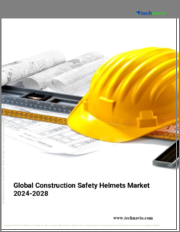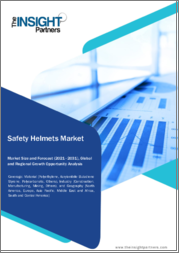
|
시장보고서
상품코드
1616117
건설 근로자 안전 시장 성장 기회, 성장 촉진요인, 산업 동향 분석 및 예측(2024-2032년)Construction Worker Safety Market Opportunity, Growth Drivers, Industry Trend Analysis, and Forecast 2024 - 2032 |
||||||
세계 건설 근로자 안전 시장은 2023년 31억 달러로 평가되었고, 2024-2032년간 연평균 7%의 성장률을 보일 것으로 예상됩니다.
이 같은 성장의 주요 원동력은 건설 현장과 같은 위험한 환경에서 일하는 근로자를 보호하기 위해 전 세계 정부와 규제 기관이 점점 더 엄격한 안전 규제를 시행하고 있기 때문입니다. 미국 OSHA(Occupational Safety and Health Administration)와 세계 각국의 유사한 프레임워크에서 정한 기준은 안전 장비 사용 의무, 종합적인 교육 프로그램, 위험 관리 프로토콜을 요구하고 있습니다. 이러한 규정을 준수하지 않을 경우 막대한 벌금과 법적 조치가 취해질 수 있기 때문에 건설 안전 솔루션에 대한 수요가 더욱 증가하고 있습니다. 최근 몇 년동안 근로자의 안전에 대한 인식이 눈에 띄게 높아졌으며, 근로자와 기업 지도자들 모두 안전에 대한 중요성을 강조하고 있습니다.
건설사들은 법규를 준수하는 데 그치지 않고 안전 문화를 업무에 통합하는 종합적인 안전 프로그램을 도입하고 있습니다. 이러한 노력은 산업재해를 줄이고, 근로자의 사기를 높이며, 생산성 저하, 의료비, 소송 가능성 등 사고와 관련된 금전적 비용을 방지하는 것을 목표로 하고 있습니다. 제품별로 개인보호장비(PPE), 낙하보호장비, 환경 모니터링 및 감지 시스템, 현장 안전 시스템 등의 카테고리로 구분되며, 2023년에는 PPE 부문이 시장 점유율의 45% 이상을 차지할 것으로 예상됩니다.
PPE에는 헬멧, 장갑, 안전 안경, 보호복, 신발 등 필수 장비가 포함되어 낙하물, 전기적 위험, 유해 물질 노출 등의 위험으로부터 보호합니다. 전 세계적으로 건설 프로젝트가 증가하고 안전 규제가 강화되면서 PPE에 대한 수요가 급증하고 있습니다. PPE는 비용 효율적이고 배치가 용이하여 특히 건설 산업에서 실용적인 선택이 되어 시장에서의 우위를 확고히 하고 있습니다. 최종 사용자별로 시장은 정부, 건설, 광업 및 자원, 에너지 및 유틸리티, 산업 부문으로 나뉩니다. 건설 부문은 첨단 안전 대책이 요구되는 건설 현장의 높은 위험성으로 인해 2023년 시장 점유율 40%를 차지할 것으로 예상됩니다. 전 세계적으로 도시화와 인프라 개발이 진행됨에 따라 이 부문의 안전 솔루션에 대한 수요는 지속적으로 증가하고 있습니다. 지역별로는 북미가 엄격한 안전 규제, 견조한 건설 산업, 지속적인 인프라 개발(특히 미국)에 힘입어 2023년 34%의 점유율로 시장을 주도할 것으로 예상됩니다.
| 시장 범위 | |
|---|---|
| 시작 연도 | 2023년 |
| 예측 연도 | 2024-2032년 |
| 시작 가격 | 31억 달러 |
| 예상 가격 | 61억 달러 |
| CAGR | 7% |
목차
제1장 조사 방법과 조사 범위
제2장 주요 요약
제3장 산업 인사이트
- 생태계 분석
- 공급업체 상황
- 원료 공급업체
- 부품 제조업체
- 기기 제조업체
- 유통업체와 딜러
- 최종사용자
- 이익률 분석
- 기술 및 혁신 전망
- 특허 분석
- 주요 뉴스 및 이니셔티브
- 규제 상황
- 영향요인
- 성장 촉진요인
- 산업의 잠재적 리스크와 과제
- 성장 가능성 분석
- Porter's Five Forces 분석
- PESTEL 분석
제4장 경쟁 구도
- 서론
- 기업별 시장 점유율
- 주요 시장 진출기업 경쟁 분석
- 경쟁 포지셔닝 매트릭스
- 전략 전망 매트릭스
제5장 시장 추정·예측 : 제품별, 2021-2032년
- 주요 동향
- 개인보호장비(PPE)
- 헬멧
- 안전 안경/고글
- 안전 장갑
- 안전화
- 청각 보호구
- 고가시성 의류
- 호흡용 보호구
- 낙하 보호 장비
- Harnesses
- Lanyards
- Anchor Points
- Guardrails
- Safety Nets
- 환경 모니터링 및 감지 시스템
- 가스 감지 시스템
- 소음 모니터링 기기
- 분진 모니터링 기기
- 현장 안전 시스템
- 알람&긴급 시스템
- 안전 표지 미 ㅊ배리어
- 구급 키트/스테이션
- 소화 설비
제6장 시장 추정·예측 : 기술별, 2021-2032년
- 주요 동향
- 스마트 PPE
- 안전 관리 소프트웨어
- 자동화 및 로보틱스
- 가상현실/증강현실(VR/AR)
- 웨어러블 센서
제7장 시장 추정·예측 : 최종사용자별, 2021-2032년
- 주요 동향
- 건설
- 관공청
- 에너지 및 유틸리티
- 광업 및 자원
- 산업
제8장 시장 추정·예측 : 지역별, 2021-2032년
- 주요 동향
- 북미
- 미국
- 캐나다
- 유럽
- 영국
- 독일
- 프랑스
- 이탈리아
- 스페인
- 러시아
- 북유럽
- 기타 유럽
- 아시아태평양
- 중국
- 인도
- 일본
- 한국
- 호주
- 동남아시아
- 기타 아시아태평양
- 라틴아메리카
- 브라질
- 멕시코
- 아르헨티나
- 기타 라틴아메리카
- 중동 및 아프리카
- 남아프리카공화국
- 사우디아라비아
- 아랍에미리트(UAE)
- 기타 중동 및 아프리카
제9장 기업 개요
- 3M
- Alpha ProTech
- Ansell Limited
- Bullard
- Delta Plus Group
- Dragerwerk AG & Co. KGaA
- DuPont
- Ergodyne
- Honeywell International Inc.
- Honeywell Safety and Productivity Solutions
- JSP Safety
- Kimberly-Clark Professional
- Lakeland Industries
- Moldex-Metric, Inc.
- MSA Safety Incorporated
- Portwest
- Radians, Inc.
- Rock Fall(Safety Footwear) Ltd.
- Tingley Rubber Corporation
- UVEX Safety Group
The Global Construction Worker Safety Market was valued at USD 3.1 billion in 2023 and is expected to grow at a CAGR of 7% from 2024 to 2032. This growth is primarily driven by increasingly stringent safety regulations imposed by governments and regulatory bodies worldwide aimed at protecting workers in hazardous environments like construction. Standards such as those set by OSHA (Occupational Safety and Health Administration) in the U.S., as well as similar frameworks globally, require the mandatory use of safety equipment, comprehensive training programs, and risk management protocols. Non-compliance with these regulations can result in heavy fines and legal repercussions, further boosting the demand for construction safety solutions. Awareness around worker safety has risen significantly in recent years, with a growing emphasis from both workers and corporate leadership.
Construction companies are increasingly adopting comprehensive safety programs that go beyond legal compliance, integrating a culture of safety within their operations. These efforts are aimed at reducing workplace accidents, improving worker morale, and avoiding the financial costs associated with accidents, including lost productivity, medical expenses, and potential lawsuits. The market is segmented based on product into categories like personal protective equipment (PPE), fall protection equipment, environmental monitoring & detection systems, and on-site safety systems. In 2023, the PPE segment held over 45% of the market share.
PPE includes essential gear such as helmets, gloves, safety glasses, protective clothing, and footwear, offering protection against hazards like falling objects, electrical risks, and exposure to harmful materials. The increasing global construction projects and stricter safety regulations have led to a surge in PPE demand. Its cost-effectiveness and ease of deployment make it a practical choice for companies, particularly in construction, solidifying its dominance in the market. By end-user, the market is categorized into government, construction, mining & resource, energy & utility, and industrial sectors.The construction sector accounted for 40% of the market share in 2023 due to the high-risk nature of construction sites, which require advanced safety measures. With urbanization and infrastructure development on the rise globally, the demand for safety solutions in this sector continues to grow. Regionally, North America led the market with a 34% share in 2023, driven by strict safety regulations, a robust construction industry, and continuous infrastructure development, particularly in the U.S.
| Market Scope | |
|---|---|
| Start Year | 2023 |
| Forecast Year | 2024-2032 |
| Start Value | $3.1 Billion |
| Forecast Value | $6.1 Billion |
| CAGR | 7% |
Table of Contents
Chapter 1 Methodology & Scope
- 1.1 Research design
- 1.1.1 Research approach
- 1.1.2 Data collection methods
- 1.2 Base estimates & calculations
- 1.2.1 Base year calculation
- 1.2.2 Key trends for market estimation
- 1.3 Forecast model
- 1.4 Primary research and validation
- 1.4.1 Primary sources
- 1.4.2 Data mining sources
- 1.5 Market definition
Chapter 2 Executive Summary
- 2.1 Industry 360° synopsis, 2021 - 2032
Chapter 3 Industry Insights
- 3.1 Industry ecosystem analysis
- 3.2 Supplier landscape
- 3.2.1 Raw Material Suppliers
- 3.2.2 Component Manufacturers
- 3.2.3 Equipment Manufacturers
- 3.2.4 Distributors and Dealers
- 3.2.5 End user
- 3.3 Profit margin analysis
- 3.4 Technology & innovation landscape
- 3.5 Patent analysis
- 3.6 Key news & initiatives
- 3.7 Regulatory landscape
- 3.8 Impact forces
- 3.8.1 Growth drivers
- 3.8.1.1 Growing awareness of workplace safety
- 3.8.1.2 Technological advancements in safety solutions
- 3.8.1.3 Increasing construction activity worldwide
- 3.8.1.4 Stringent regulatory standards
- 3.8.2 Industry pitfalls & challenges
- 3.8.2.1 High cost of advanced safety equipment and solutions
- 3.8.2.2 Complexity of managing safety across diverse construction sites
- 3.8.1 Growth drivers
- 3.9 Growth potential analysis
- 3.10 Porter's analysis
- 3.11 PESTEL analysis
Chapter 4 Competitive Landscape, 2023
- 4.1 Introduction
- 4.2 Company market share
- 4.3 Competitive analysis of major market players
- 4.4 Competitive positioning matrix
- 4.5 Strategic outlook matrix
Chapter 5 Market Estimates & Forecast, By Product, 2021-2032 ($Bn, Units)
- 5.1 Key trends
- 5.2 Personal Protective Equipment (PPE)
- 5.2.1 Helmets
- 5.2.2 Safety Glasses/Goggles
- 5.2.3 Safety Gloves
- 5.2.4 Safety Footwear
- 5.2.5 Hearing Protection
- 5.2.6 High-Visibility Clothing
- 5.2.7 Respiratory Protection
- 5.3 Fall Protection Equipment
- 5.3.1 Harnesses
- 5.3.2 Lanyards
- 5.3.3 Anchor Points
- 5.3.4 Guardrails
- 5.3.5 Safety Nets
- 5.4 Environmental Monitoring & Detection Systems
- 5.4.1 Gas Detection Systems
- 5.4.2 Noise Monitoring Devices
- 5.4.3 Dust Monitoring Devices
- 5.5 On-Site Safety Systems
- 5.5.1 Alarms & Emergency Systems
- 5.5.2 Safety Signage & Barriers
- 5.5.3 First-Aid Kits/Stations
- 5.5.4 Fire Extinguishing Equipment
Chapter 6 Market Estimates & Forecast, By Technology, 2021-2032 ($Bn, Units)
- 6.1 Key trends
- 6.2 Smart PPE
- 6.3 Safety Management Software
- 6.4 Automation & Robotics
- 6.5 Virtual and Augmented Reality (VR/AR)
- 6.6 Wearable Sensors
Chapter 7 Market Estimates & Forecast, By End-User, 2021-2032 ($Bn, Units)
- 7.1 Key trends
- 7.2 Construction
- 7.3 Government
- 7.4 Energy & Utility
- 7.5 Mining & Resource
- 7.6 Industrial
Chapter 8 Market Estimates & Forecast, By Region, 2021-2032 ($Bn, Units)
- 8.1 Key trends
- 8.2 North America
- 8.2.1 U.S.
- 8.2.2 Canada
- 8.3 Europe
- 8.3.1 UK
- 8.3.2 Germany
- 8.3.3 France
- 8.3.4 Italy
- 8.3.5 Spain
- 8.3.6 Russia
- 8.3.7 Nordics
- 8.3.8 Rest of Europe
- 8.4 Asia Pacific
- 8.4.1 China
- 8.4.2 India
- 8.4.3 Japan
- 8.4.4 South Korea
- 8.4.5 Australia
- 8.4.6 Southeast Asia
- 8.4.7 Rest of Asia Pacific
- 8.5 Latin America
- 8.5.1 Brazil
- 8.5.2 Mexico
- 8.5.3 Argentina
- 8.5.4 Rest of Latin America
- 8.6 MEA
- 8.6.1 South Africa
- 8.6.2 Saudi Arabia
- 8.6.3 UAE
- 8.6.4 Rest of MEA
Chapter 9 Company Profiles
- 9.1 3M
- 9.2 Alpha ProTech
- 9.3 Ansell Limited
- 9.4 Bullard
- 9.5 Delta Plus Group
- 9.6 Dragerwerk AG & Co. KGaA
- 9.7 DuPont
- 9.8 Ergodyne
- 9.9 Honeywell International Inc.
- 9.10 Honeywell Safety and Productivity Solutions
- 9.11 JSP Safety
- 9.12 Kimberly-Clark Professional
- 9.13 Lakeland Industries
- 9.14 Moldex-Metric, Inc.
- 9.15 MSA Safety Incorporated
- 9.16 Portwest
- 9.17 Radians, Inc.
- 9.18 Rock Fall (Safety Footwear) Ltd.
- 9.19 Tingley Rubber Corporation
- 9.20 UVEX Safety Group

















